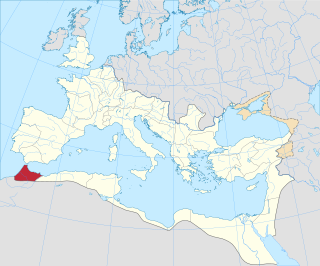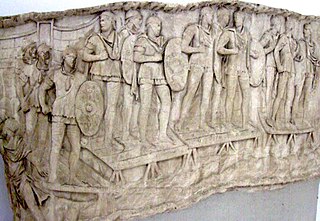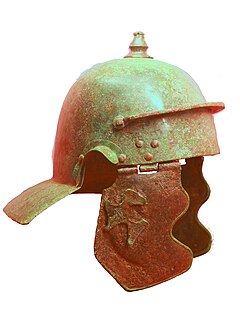| Cohors V Delmatarum | |
|---|---|
 Roman infantry helmet (late 1st century) | |
| Active | early 1st century to at least late 2nd century |
| Country | Roman Empire |
| Type | Roman auxiliary cohort |
| Role | infantry |
| Size | 480 men |
| Garrison/HQ | Germania Superior 74-185 |
Cohors quinta Delmatarum ("5th Cohort of Dalmatae") was a Roman auxiliary infantry unit. It is named after the Dalmatae, an Illyrian-speaking tribe that inhabited the Adriatic coastal mountain range of the eponymous Dalmatia. The ancient geographer Strabo describes these mountains as extremely rugged, and the Dalmatae as backward and warlike. He claims that they did not use money long after their neighbours adopted it and that they "made war on the Romans for a long time". He also criticises the Dalmatae, a nation of pastoralists, for turning fertile plains into sheep pasture. [1] Indeed, the name of the tribe itself is believed to mean "shepherds", derived from the Illyrian word delme ("sheep"). [2] The final time this people fought against Rome was in the Illyrian revolt of 6-9 AD. The revolt was started by Dalmatae auxiliary forces and soon spread all over Dalmatia and Pannonia. The resulting war was described by the Roman writer Suetonius as the most difficult faced by Rome since the Punic Wars two centuries earlier. But after the war, the Dalmatae became a loyal and important source of recruits for the Roman army.

The Dalmatae or Delmatae were an ancient people who inhabited the core of what would then become known as Dalmatia after the Roman conquest at the eastern Adriatic coast, in what is present-day Croatia and Bosnia and Herzegovina, between the rivers Krka, on the northwest, the Neretva on the east, and the river Rama on the northeast. The Delmatae are mostly classed as an Illyrian tribe.

Dalmatia is one of the four historical regions of Croatia, alongside Croatia proper, Slavonia, and Istria.

Strabo was a Greek geographer, philosopher, and historian who lived in Asia Minor during the transitional period of the Roman Republic into the Roman Empire.
Contents
According to Holder, a total of 12 cohortes Delmatarum appear to have been raised after the suppression of the Illyrian revolt in two series, of 7 and 5 respectively. All these units were in existence by the time of emperor Claudius (r. 41-54) [3] Of these, 9 appear to have survived into the 2nd century. [4]

Claudius was Roman emperor from AD 41 to 54. A member of the Julio-Claudian dynasty, he was the son of Drusus and Antonia Minor. He was born at Lugdunum in Gaul, the first Roman Emperor to be born outside Italy. Because he was afflicted with a limp and slight deafness due to sickness at a young age, his family ostracized him and excluded him from public office until his consulship, shared with his nephew Caligula in 37.
The regiment was probably raised by founder-emperor Augustus (r. 30BC-14AD) after 9 AD. It was certainly in existence by the time of Claudius (r. 41-54). [3] It is unclear why two cohortes Delmatarum were given the same number V: this regiment and cohors V Delmatarum c.R. in Mauretania Tingitana). Spaul suggests the regiment in Mauretania may be the cohors I Liburnorum renamed. [5] The regiment first appears in the datable epigraphic record in 74 AD in Germania (prob. Superior). It was still in Germania Superior in 185, the time of its last datable inscription. [6] The regiment's tile stamp has been found at the Roman fort of Böckingen and epitaphs at Arnsburg, Moguntiacum and Wiesbaden.

Augustus was a Roman statesman and military leader who was the first emperor of the Roman Empire, reigning from 27 BC until his death in AD 14. His status as the founder of the Roman Principate has consolidated an enduring legacy as one of the most effective and controversial leaders in human history. The reign of Augustus initiated an era of relative peace known as the Pax Romana. The Roman world was largely free from large-scale conflict for more than two centuries, despite continuous wars of imperial expansion on the Empire's frontiers and the year-long civil war known as the "Year of the Four Emperors" over the imperial succession.
Cohors quinta Delmatarum civium Romanorum was a Roman auxiliary infantry regiment. It is named after the Dalmatae, an Illyrian-speaking tribe that inhabited the Adriatic coastal mountain range of the eponymous Dalmatia. The ancient geographer Strabo describes these mountains as extremely rugged, and the Dalmatae as backward and warlike. He claims that they did not use money long after their neighbours adopted it and that they "made war on the Romans for a long time". He also criticises the Dalmatae, a nation of pastoralists, for turning fertile plains into sheep pasture. Indeed, the name of the tribe itself is believed to mean "shepherds", derived from the Illyrian word delme ("sheep"). The final time this people fought against Rome was in the Illyrian revolt of AD 6-9. The revolt was started by Dalmatae auxiliary forces and soon spread all over Dalmatia and Pannonia. The resulting war was described by the Roman writer Suetonius as the most difficult faced by Rome since the Punic Wars two centuries earlier. But after the war, the Dalmatae became a loyal and important source of recruits for the Roman army.

Mauritania Tingitana was a Roman province located in the Maghreb, coinciding roughly with the northern part of present-day Morocco. The territory stretched from the northern peninsula opposite Gibraltar, to Sala Colonia and Volubilis to the south, and as far east as the Mulucha river. Its capital city was Tingis, which is the modern Tangier. Other major cities of the province were Iulia Valentia Banasa, Septem, Rusadir, Lixus and Tamuda.
The names of 1 praefectus (regimental commander) and 2 centuriones (infantry officers) are preserved, without origins. The names of 3 caligati (common soldiers) are also preserved, two of whom were Illyrians. [5]

A centurion was a professional officer of the Roman army after the Marian reforms of 107 BC. Most centurions commanded groups of centuries of around 100 legionaries, but senior centurions commanded cohorts or took senior staff roles in their legion. Centurions were also found in the Roman navy. In the Byzantine Army, they were also known by the name kentarch. Their symbol of office was the vine staff, with which they disciplined even Roman citizens protected from other forms of beating by the Porcian Laws.



